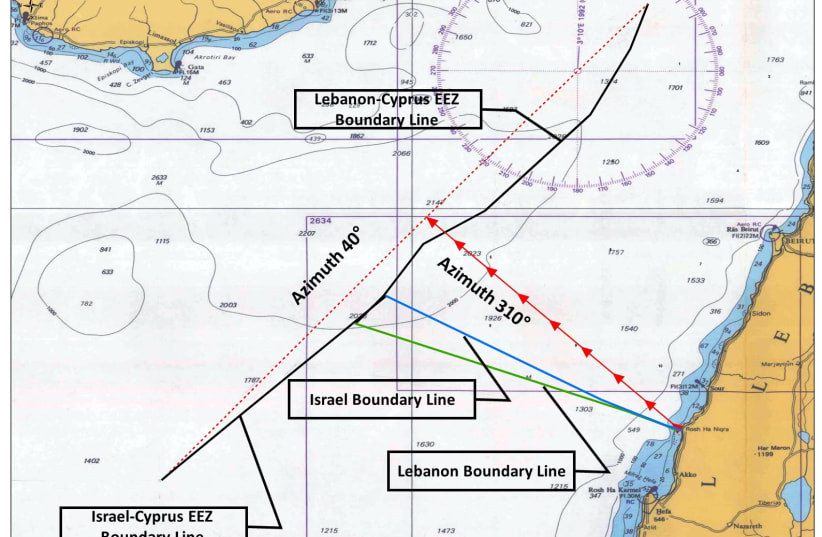Israel prepared to respond to increased demands from Lebanon by claiming more than double the area of the Mediterranean Sea that is currently in dispute, according to a map obtained by The Jerusalem Post on Monday.
The map shows what the Energy Ministry has called “Line 310,” or the red line, which extends significantly further north than Israel’s starting negotiating position, the blue line on the map.
Israel and Lebanon began US-mediated negotiations on their maritime border in October, which were the first talks between the countries in 30 years. The countries hope that settling the border would encourage further gas exploration in the area.
Israel already pumps significant amounts of gas from the Mediterranean, but Lebanon has yet to do so.
The Lebanese delegation would not speak directly to the Israelis in the talks at Naqoura, a UN base on the Israel-Lebanon border, and faced significant pressure from Hezbollah to abandon the negotiations.
After four rounds of talks, negotiations stopped in November. Energy Minister Yuval Steinitz accused Lebanon of changing its position seven times, presenting “positions that add up to a provocation.”
The blue and green lines on the map represent the countries’ official positions, as submitted to the UN. The disputed area starts from the countries’ border on the Mediterranean Sea and is 5 km. to 6 km. wide on average. The area originally under dispute would be about 2% of Israel’s economic waters.
During negotiations, Lebanon increased its demand with a line extending much further south, increasing the disputed area from about 860 sq.km. to 2,300 sq.km.
Two weeks ago, Lebanese Public Works and Transport Minister Michel Najjar said the government had signed a decree expanding its exclusive economic zone in the Mediterranean Sea to the extent presented in the negotiations, adding that it would be submitted to the UN.
“We will not give up any inch of our homeland, or a drop of its waters or an inch of its dignity,” he said.
Steinitz then ordered that Israel make maximalist demands of its own to counter the Lebanese claims, and the Energy Ministry drew up the map with the new line.
“This wasn’t our original intention, but the moment Lebanon moved forward with submitting their line, we prepared to submit ours, which, in symmetry with theirs, encroaches on hundreds of kilometers of Lebanon’s economic waters,” a ministry source said Monday.
Israel’s new line is based on the maritime borders between Cyprus and Lebanon.
“It doesn’t promote a solution, but it creates symmetry,” the source said.
Lebanese President Michel Aoun has yet to sign the decree expanding Lebanon’s maritime borders and submit the new map to the UN.
As such, Israel has withheld its map, “out of a real desire to give continued negotiations a chance,” the Energy Ministry source said.
Last week, following a meeting with Aoun, US Undersecretary of State for Political Affairs David Hale said negotiations between Israel and Lebanon “have potential to unlock significant economic benefits for Lebanon.”
“This is all the more critical against the backdrop of the severe economic crisis the country is facing,” he said.
The Energy Ministry source expressed hope that under the Biden administration the talks will restart and be productive.
Reuters contributed to this report.
